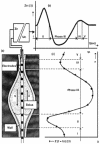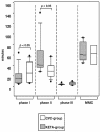Effects of a single dose of ketamine on duodenal motility activity in pigs
- PMID: 15825517
- PMCID: PMC1082863
Effects of a single dose of ketamine on duodenal motility activity in pigs
Abstract
In order to investigate the effects of a single dose of ketamine on duodenal motility, the present study focused on the electric impedance technique. Five pigs (32 to 40 kg, CVC group) were instrumented with a central venous catheter 1 d before measurements. The next day, general anesthesia was started and maintained via central venous catheter by propofol and fentanyl. In contrast, the pigs of the KETA group (n = 5) received ketamine intramuscularly prior to the induction of anesthesia by the injection of propofol-fentanyl via an ear vein. An intraluminal impedance catheter was manually introduced into the proximal duodenum. Measurements were recorded for 4 h. The KETA group showed a median duration of phase II that was shortened by 35%, while phase I was prolonged by 73% (P < 0.05). In conclusion, when gastrointestinal motility has to be investigated, the effects of a single dose of ketamine, even for premedication, should be taken into consideration.
Résumé — Effets d’une dose unique de kétamine sur la motilité duodénale du porc. Cette expérience, basée sur une technique d’impédance électrique, a été réalisée dans le but d’étudier les effets d’une dose unique de kétamine sur la motilité duodénale. Un cathéter veineux central a été mis en place chez 5 porcs d’un poids de 32 à 40 kg (groupe CVC) un jour avant l’expérimentation. Le jour suivant, une anesthésie générale a été induite et maintenue via le cathéter veineux central à l’aide de propofol et de fentanyl. Par ailleurs, les 5 porcs du groupe KETA ont reçu de la kétamine par voie intramusculaire avant l’induction de l’anesthésie par injection de propofol-kétamine par une veine de l’oreille. Un cathéter intraluminal à impédance a été introduit manuellement dans le duodénum proximal. Les résultats ont été enregistrés pendant 4 heures. Le groupe KETA a montré une diminution de la durée médiane de la phase 11 de 35 % alors que la phase 1 était prolongée de 73 % (P < 0,05). En conclusion, lorsque la motilité gastro-intestinale doit être évaluée, les effets d’une dose unique de kétamine, même en prémédication, devraient être pris en considération.
(Traduit par Docteur André Blouin)
Figures



Similar articles
-
Effects of propofol and fentanyl on duodenal motility activity in pigs.Can Vet J. 2005 Nov;46(11):995-1001. Can Vet J. 2005. PMID: 16363326 Free PMC article.
-
Duodenal motility is not affected during duodenotomy in pigs.Acta Vet Hung. 2006 Jun;54(2):251-61. doi: 10.1556/AVet.54.2006.2.11. Acta Vet Hung. 2006. PMID: 16841762
-
Effects of feeding a standard diet on duodenal impedancometry in pigs.Acta Vet Hung. 2006 Mar;54(1):85-93. doi: 10.1556/AVet.54.2006.1.9. Acta Vet Hung. 2006. PMID: 16613029
-
A long-term porcine model for measurement of gastrointestinal motility.Lab Anim. 2003 Apr;37(2):145-54. doi: 10.1258/00236770360563796. Lab Anim. 2003. PMID: 12689426
-
Ketamine and its use in the pig. Recommendations of the Consensus meeting on Ketamine Anaesthesia in Pigs, Bergen 1994. Ketamine Consensus Working Group.Lab Anim. 1996 Jul;30(3):209-19. doi: 10.1258/002367796780684863. Lab Anim. 1996. PMID: 8843045 Review.
Cited by
-
Effects of propofol and fentanyl on duodenal motility activity in pigs.Can Vet J. 2005 Nov;46(11):995-1001. Can Vet J. 2005. PMID: 16363326 Free PMC article.
-
Anoplasty and rectovaginal fistula repair in a gilt with atresia ani: A case report.Can Vet J. 2023 Nov;64(11):1009-1014. Can Vet J. 2023. PMID: 37915787 Free PMC article.
-
Short-term elevation of intracranial pressure does neither influence duodenal motility nor frequency of bolus transport events: a porcine model.BMC Emerg Med. 2006 Jan 25;6:1. doi: 10.1186/1471-227X-6-1. BMC Emerg Med. 2006. PMID: 16433933 Free PMC article.
-
Magnetic Resonance Imaging of Gastric Motility in Conscious Rats.Neurogastroenterol Motil. 2024 Dec 31:e14982. doi: 10.1111/nmo.14982. Online ahead of print. Neurogastroenterol Motil. 2024. PMID: 39737873
-
Suppression of mICAT in Mouse Small Intestinal Myocytes by General Anaesthetic Ketamine and its Recovery by TRPC4 Agonist (-)-englerin A.Front Pharmacol. 2020 Dec 18;11:594882. doi: 10.3389/fphar.2020.594882. eCollection 2020. Front Pharmacol. 2020. PMID: 33390980 Free PMC article.
References
-
- Lin HC. Dissociative Anesthetics. In: Thurmon JC, Tranquilli WJ, Benson J, eds. Lumb & Jones’ Veterinary Anesthesia. Third Edition. Philadelphia: Lippincott Williams & Wilkins, 1993:241–296.
-
- Dick W, Hofmann S. Effect of dehydrobenzperidol, fentanyl and ketamines on the intestinal motility in young dogs. (Article in German) Anaesthesist. 1970;19:205–208. - PubMed
-
- Fass J, Bares R, Hermsdorf V, Schumpelick V. Effects of intravenous ketamine on gastrointestinal motility in the dog. Intensive Care Med. 1995;21:584–589. - PubMed
-
- An YJ, Lee H, Chang D, et al. Application of pulsed Doppler ultrasound for the evaluation of small intestinal motility in dogs. J Vet Sci. 2001;2:71–74. - PubMed
-
- Herbert MK, Kuhn H, Roewer N. Effect of racemic and S(+)- ketamine on the peristaltic reflex in guinea-pig ileum in vitro. Comparison to fentanyl. (Article in German). Anästhesiol Intensivmed Notfallmed Schmerzther. 1998;33:613–614.
Publication types
MeSH terms
Substances
LinkOut - more resources
Full Text Sources
